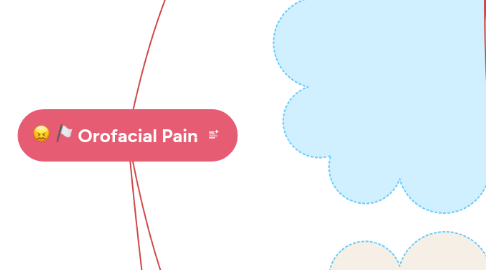
1. Non-dental pain
1.1. Temporomandibular joint disorder (Peck et al. 2014)
1.1.1. Masticatory muscle disorder
1.1.1.1. Involves lateral & medial pterygoid muscle,masseter, temporalis
1.1.2. TMJ disorder
1.1.3. Headache attributed to TMD
1.1.3.1. Most prominent in temporal region, during clenching or grinding teeth, the pain from the muscle gives headache like pain
1.1.4. Coronoid hyperplasia
1.1.4.1. Enlarged coronoid process causing difficulty in opening mouth
1.2. Neuropathic (Merskey & Bogduk 1994)
1.2.1. Trigeminal neuralgia
1.2.2. Acute herpes zoster
1.2.2.1. Usually in older patient. HZ is caused by reactivation of Varicella Zoster virus that is present during childhood and remains latent in nervous ganglia. Pain of tingling sensation on one side of face
1.2.3. Glossopharyngeal neuralgia
1.2.3.1. Pain in back of throat, tongue or ear
1.2.4. Occipital neuralgia
1.2.4.1. Pain on upper neck,back of the head or behind ear
1.2.5. Hyoglossal neuralgia
1.2.5.1. Paralysis of tongue
1.3. Sinus
1.3.1. Maxillary sinusitis
1.4. Referred pain (Scully & Porter 1999)
1.4.1. Angina
1.5. Psychogenic (Scully & Porter 1999)
1.5.1. Atypical facial pain
1.5.1.1. Burning, pulling sensation on side of face often in the region of trigeminal nerve. But rarely as severe as trigeminal neuralgia
1.5.2. Burning mouth syndrome
1.5.2.1. Burning sensation of mouth without obvious cause
2. Periodontal pain (Lang & Lindhe 2015)
2.1. Necrotising periodontal disease
2.2. Aggresive periodontal disease
2.2.1. In healthy patient usually younger people
3. Pulpal pain
3.1. deep, dull, non-localised (De Leeuw, R., et al. 2018)
3.1.1. Dentinal origin
3.1.1.1. Dentine hypersensitivity
3.1.1.2. Exposed tubules by tooth fracture, caries, or receding gums
3.1.2. Pulpitis (De Leeuw, R., et al. 2018)
3.1.2.1. Reversible pulpitis
3.1.2.1.1. Pain only when in contact with stimulus, recedes when stimulus is removed
3.1.2.2. Irreversible pulpitis
3.1.2.2.1. Pain is prolonged, regardless of presence with stimulus or not; may progress to pulpal necrosis
3.1.3. Non-vital tooth pain (pulpal necrosis)
3.1.3.1. Cause: untreated pulpitis, exposure to oral bacteria, traumatic injury, long-term disruption of blood supply to the tissue
3.1.3.2. Periapical involvement

